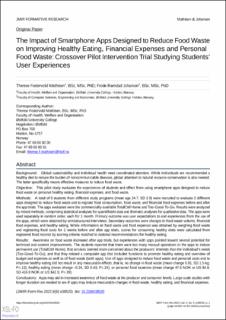| dc.description.abstract | Background:
Global sustainability and individual health need coordinated attention. While individuals are recommended a healthy diet to reduce the burden of noncommunicable diseases, global attention to natural resource conservation is also needed. The latter specifically means effective measures to reduce food waste.
Objective:
This pilot study evaluates the experiences of students and effect from using smartphone apps designed to reduce food waste on personal healthy eating, financial expenses, and food waste.
Methods:
A total of 6 students from different study programs (mean age 24.7, SD 2.9) were recruited to evaluate 2 different apps designed to reduce food waste and to register food consumption, food waste, and financial food expenses before and after the app trials. The apps evaluated were the commercially available TotalCtrl Home and Too-Good-To-Go. Results were analyzed by mixed methods, comprising statistical analyses for quantifiable data and thematic analyses for qualitative data. The apps were used separately in random order, each for 1 month. Primary outcome was user expectations to and experiences from the use of the apps, which were obtained by semistructured interviews. Secondary outcomes were changes in food waste volume, financial food expenses, and healthy eating. While information on food waste and food expenses was obtained by weighing food waste and registering food costs for 2 weeks before and after app trials, scores for consuming healthy diets were calculated from registered food records by scoring criteria matched to national recommendations for healthy eating.
Results:
Awareness on food waste increased after app trials, but experiences with apps pointed toward several potential for technical and content improvements. The students reported that there were too many manual operations in the apps to induce permanent use (TotalCtrl Home), that services seemed more concerned about the producers’ interests than the individual’s needs (Too-Good-To-Go), and that they missed a composite app that included functions to promote healthy eating and overview of budget and expenses as well as of food waste (both apps). Use of apps designed to reduce food waste and personal costs and to improve healthy eating did not result in any measurable effects, that is, no change in food waste (mean change 0.81, SD 1.5 kg; P=.13), healthy eating (mean change –0.24, SD 0.43; P=.24), or personal food expenses (mean change 47.5 NOK or US $4.8, SD 416.9 NOK or US $42.5; P=.39).
Conclusions:
Apps may aid in increased awareness of food waste at the producer and consumer levels. Large-scale studies with longer duration are needed to see if apps may induce measurable changes in food waste, healthy eating, and financial expenses. | en_US |

